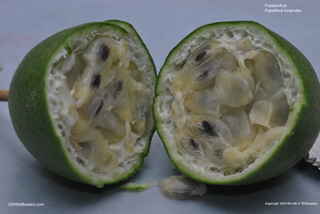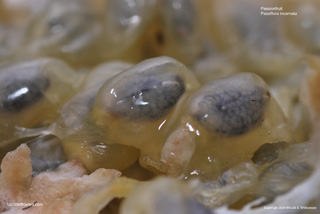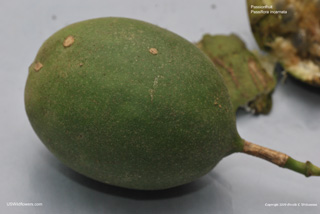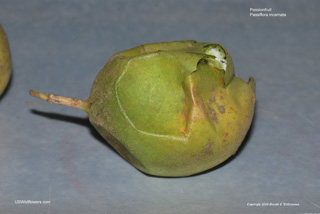The picture above is the fruit of Tennessee’s State Wildflower – Passionflower, Passiflora incarnata. I can report reliably that it is edible, similar to the species which is frequently cultivated in tropical regions – Passiflora edulis, although P. incarnata fruit is typically smaller than that of P. edulis. Passiflora incarnata is a plant native to the United States, while Passiflora edulis has been introduced to the United States and is found in the wild in Georgia and Florida.
The flavor of P. incarnata is tartly-sweet. My daughter Amie, who snacked on Passionfruit routinely as a missionary in Papua New Guinea, says it reminds her of the Nerds candy she loved as a child. However, it’s a bit of a chore enjoying the flavor, and getting past the slimy texture of the mass of seeds may put some folks off.
There are many seeds inside the fruit, imbedded in a slimy covering. It is this gelatinous covering that provides the tart flavor of the fruit, and extricating the seeds from the goo can be a tedious task. This difficulty might also be one of the reasons the fruit of our native passionflower is not a well-known wild snack.
The fruit of Passiflora incarnata is fairly small, a bit larger than a golf ball. I was expecting it to start turning purple as it ripened, but that wasn’t the case, as is seen in the photo below. The fruit stays green, gaining tinges of yellow as it ripens. This photo is an example of a properly-ripened fruit.
If you wait too long, when the fruit has much of a yellow color, it’s really too ripe. At this point the fruit will have a sweeter flavor, but it is to me more of a rotten-sweet flavor than a sugary sweet flavor. I much preferred the flavor of the less-ripe fruit.
I’m not real experienced with this fruit. My sister Ann, who lives outside of Nashville, had a colony that was growing on her barn, so she harvested several of them, tasted them, and forwarded several of them on to me by my granddaughter Sydney. We’ve determined that for the better, tart flavor, you need to harvest and eat the fruit just as it starts to soften – you should be able to squeeze it gently and have it give just a bit. If it crushes easily like the one above, it’s probably past the best flavor.
So, Passiflora incarnata not only has beautiful wildflowers, it also has fruit that can make an… interesting… treat. Check out more photographs of this interesting plant at USWildflowers’ detail page on Passiflora incarnata.Disclaimer: Please do not eat any plant based on my written recommendation. I am not an expert and may be wrong. You may not properly identify the plant. You may have an unexpected allergic reaction to a plant that others can eat safely. (I’m sure that if I had lawyers, they would force me to include the above statement, probably in unintelligible language.)





Another interesting fact about the passion flower plant is that it is a host plant for the Gulf Fritillary Butterfly. We have them on our grape arbor and enjoy the butterflies, larvae, and pupae as much as the flowers and fruit.
Thanks for the info, and for the visit to USWildflowers.com, Janice.
I really love passion flower because it helps me to reduce my own anxiety. I find passion flower to be very relaxing and quite easily helps me sleep at night. *`*`’
Many thanks
how do you use the passion flower in a tea, is it the whole flower dried?
Barbara – I’m not a herbalist, just a wildflower enthusiast, so I’m not familiar with most of the recipes for use of plants. However, here’s a link that may be helpful – https://www.anniesremedy.com/chart_remedy.php?rem_ID=304
barbara milka i’ve just discovered many large plants in last 2 yrs. .google sites say very poisonous plant and fruit is too unless ripe. DO your research.. All my plants stay green .None have turned purple or the yellowish tint people talk of .I’m in central oklahoma. This yr I’ve been brave enough to eat 3 that where ‘wrinkled but still green. Flavor like a lemon flavored paw paw fruit. Be careful and enjoy
Do you consume the fruit for the relaxant?
The scent of the flower?
I spent Years in Central Florida; the easiest way to enjoy the fruit is to cut open, suck all of the insides out! You can use a spoon to break the white pectin (it holds the seeds/goo in place). The scoop each side of the cut fruit into the spoon and eat. I found them to be full of energy. Good source of vitamin C. The tropical variety is best when a little ‘over’ ripe/ sweeter and juicier. I am so very pleased to have found this flower and fruit in KY. I look forward to tasting the ripened fruit, which is still a flower!
Thank You!
Passionfruit is great to make limonade. Just add the flesh of a couple of passionfruits to a litre of water. Add juice of 1 or 2 lemons and sugar to taste. Stir and wait fot som time. The limonade gets the passionfruit taste.
You can press the pulp through a sieve if you don’t want to eat the seeds, but they are nutritious. Tinctures or teas made from the leaves may be effective sleep aids or anti-anxiety treatment. Fruits of all Passiflora species are toxic when unripe, but the toxins disappear as the fruit ripens. Best to let them drop off themselves to guarantee full ripeness. In the garden P. incarnata will sucker, sometimes several feet from the original plant. Growing in a large pot or tub will contain it. The fruits vary from plant to plant, but the best have a rich tropical aroma of pineapple punch and sweet complex flavours. Mine are not tart at all when ripe.
I had no idea they were toxic when underripe. I used to pick them when I was a kid living in Tennessee. They were delicious!